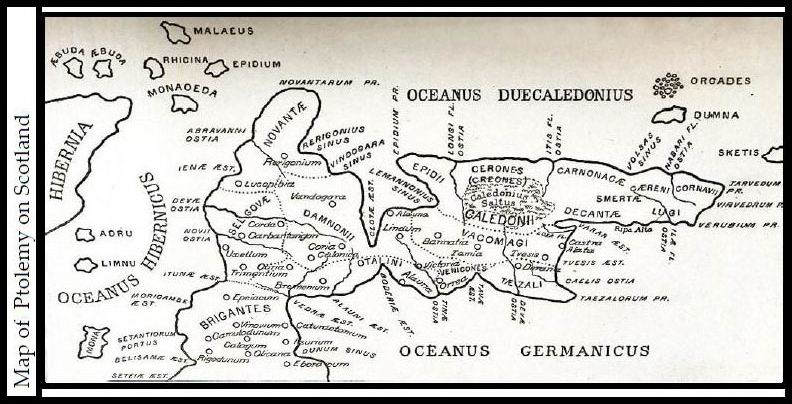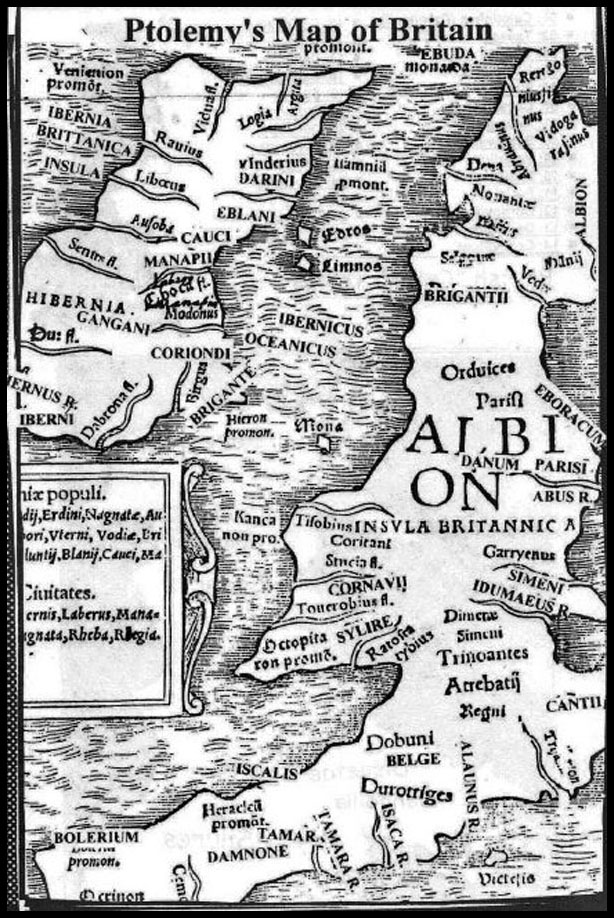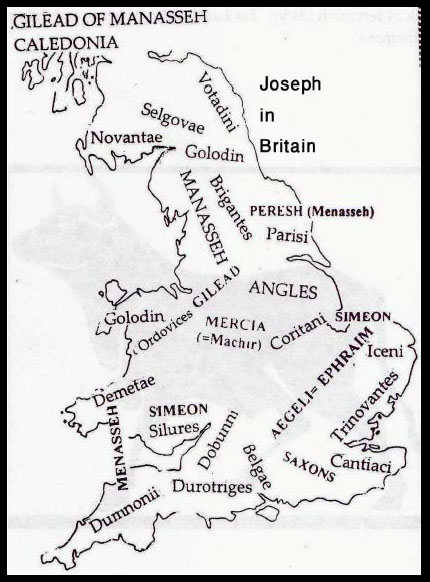PTOLEMY ON THE BRITISH ISLES (1 September 2015, 17 Elul 5775)


Claudius Ptolemy (c. 100 - c. 170 CE) was a native of Alexandria in Egypt. He wrote in Greek. He used Babylonian and Phoenician sources. very little is known for certain about him.
ptolemy wrote the Almagest which is the only surviving comprehensive ancient treatise on astronomy.
He also wrote his Geography (also called the Geographia), a compilation of geographical coordinates of the part of the world known to the Roman Empire during his time. He relied somewhat on the work of an earlier geographer, the Phoenician, Marinos of Tyre, and on gazetteers of the Roman and ancient Persian Empire. He also acknowledged the ancient astronomer Hipparchus for having provided the elevation of the north pole for a few cities.
The maps in different editions of the Geography of Ptolemy are the product of later compilers basing themselves on the descriptions given by Ptolemy.
Ptolemy's Map of Britain shows the Tribal situation in the Celtic era but is not all-inclusive. Other groups not mentioned by Ptolemy are known to have been in Britain according to Roman and later Celtic accounts though at all events Ptolemy's description is, on the whole, the best available. The information on which these maps are based dates from before the Anglo-Saxon and Viking conquests. In Northeast SCOTLAND (Albion) Ptolemy placed the LUGI. The Lugi were also reported on the Continent near the Vistula River and, like the Lygi, are considered part of the Vandals or a Celtic people whom the Vandals absorbed. The Vandals were destined to settle in Northern England and Lowland Scotland and descend from Asher. The name Lugi is based on a word-root connoting "union" which has the same meaning as "Heber" [Cheber] from the Tribe of Asher (Genesis 46:17). This is a phenomenon that repeats itself. We will often find different peoples from one particular Tribe having been in the same general area, i.e. having come one after the other tot he same places, even though they belonged to different cultural bodies (e.g. one was Celtic, the other Germanic-speaking) and there had been no contact between themselves.
The CALEDONII relate to Gilead of Manasseh and the Galatae. ALAUNA reminds one that the name ALAN was to be found amongst the Celtic Scotch suggesting a connection with the Alans of Scythia who came from Elon, son of Zebulon (Genesis 46:14). The presence of the GADENI near here is known from other sources. The Gadeni came from Gad.
The names ALBA and ALBION imply a relationship with Albania of the Caucasus from which area part of the Picts traditionally came. The names "Alba" and "Albion" are also cognate with Lebanon. The Picts were in this part of Scotland and derived from the Agathyrsi, as did the Khazars. The DON RIVER of Scotland is in this region and there was another Don River to the south confluent with the Humber in Northern England and passing by the city of Danum. The Don Rivers are reminiscent of the Don River in Scythia and the Tribe of DAN.
The DAMNONII also relate to DAN. The BRIGANTES came from BERIAH (Beria-g-h), son of Asher (Genesis 46:17), and were also found in Switzerland and Southeast Ireland.
The PARISI came from Peresh son of Machir and part of Gilead, meaning the Galatae. They were centered about Eburacum (York City of Hebrews) and also were in Gaul where they gave their name to Paris, the capital city. The ABUS River (i.e. the Humber) bears a name recalled in the Abi Scythae who came from Job, son of Issachar (Genesis 46:13), near Scythian Serica. The SIMENI came from Simeon of Israel. They adjoined the Iceni of Yacin, son of Simeon, and on their border was the IDUMAUS River, just as in the Land of Israel Idumea (Edom) bordered the territory of Simeon and was in part conquered and settled by Simeonites. The SYLIRES (Silures) of Southern Wales came from Saul, son of Simeon. The ALAUNUS River in the south parallels the presence of ALAUNA town in the north.
The ISACA River was named after ISAAC, father of Israel, just as the Usk River in Silure territory of Southern Wales was named Isc and flowed by the town of ISCA. The TAMARUS River in the south was named after TAMAR, a wife of Judah, and mother of Perez and Zerah, sons of Judah. The territory of Judah had adjoined that of Dan and the DAMNONES were also called Dannonians and Daunians and relate to Dan, as do the DAMNONII in Scotland and the Damnae of Scythian Serica.
In IRELAND existed a portion of BRIGANTES from Beriah of Asher (Genesis 46:17). The IBERNI suggest Iberia in the Caucasus, a place of Israelite exile. The Scotch and Irish Gaels called themselves IBERI or Hiberi which name means HEBREW. All the inhabitants of the British Isles were known as Iberi meaning Hebrews. The MANAPII were recalled in the Menapii of Holland and Menapia of Bactria east of the Caspian Sea. The CAUCI were paralleled by the Chauki Franks in Europe and the Cachage Scythae of Scythia, descended from Hagi (Chagi) of Gad. Irish Mythology is replete with Hebrew sounding names and ancestral appellations similar to Israelite Tribal Clans. On the West Coast (Mayo region) Ptolemy located the Venicni who were related to the Venetes in Brittany (France) and the Galedoni in North Wales.
Additional Celtic-British associations with Biblical Patriarchs include Gebar of Manasseh:Â Gabrontovices, Gabraige, Gabair, Gabreta, Guberni, Gabran, Gabair, Girvii, etc.; Gomer = Mont-gomery, Gumeraeg, etc.; Eladah of Ephraim = Uladah (i.e. Ulster); Abel beth Maachah of Nephtali = Emain Macha of Ireland; Maachah of Manasseh = Machah of Ireland; Israel= Isru; Keren (i.e. Karnayim of East Manasseh) = The god Cernunnos and numerous tribal names especially in Scotland and West Britain bearing the root CRN; Oriel = The province of Oriel in Ireland.

